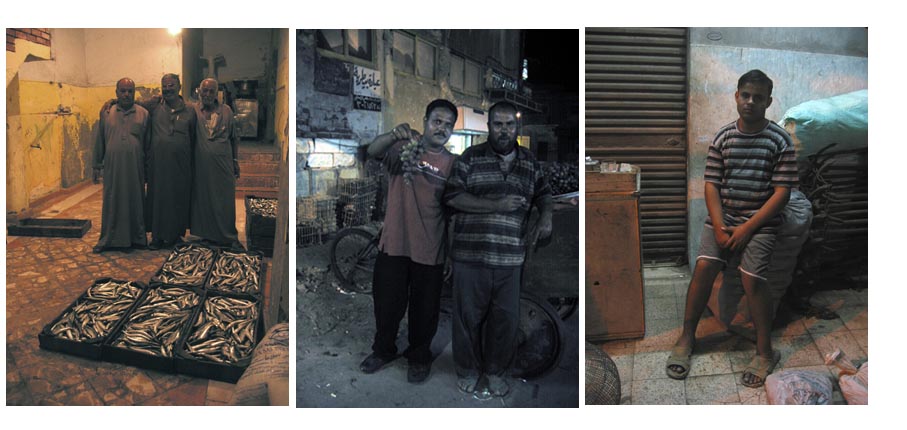Sue Williamson a mené un travail très simple mais très efficace en termes de rencontre avec les habitants et d’inscription dans le site d’El Max. Elle a rencontré des gens et leur a demandé ce qu’ils pensaient de leur lieu de vie. Elle a alors peint leur réponse sur le mur de leur maison en anglais et en arabe.
Les images ici montrées sont extraites du passeport d’artiste publié par les éditions de l’oeil, sur le travail de Sue Williamson.
Elle a par ailleurs photographié les pêcheurs d’El Max, ensemble de photos qui ont été montrées quelques mois plus tard à la Biennale d’Alexandrie. A cette occasion elle est revenue à El Max finir le travail de peinture sur les maisons.
In El Max, a small fishing community in the city of Alexandria, Egypt, life is lived much as it has been for centuries. In the main street, not much happens during the day, but as the sun goes down, the small shops open and the men come out to enjoy the night, smoke shisha pipes and play dominoes in the café while the women stay in their homes.
Men of El Max documents the night life of the street in a grid of nine photographs, taken in available light at night of Achmad, owner of the café, the fish merchants, the sellers of cigarettes and lighters, the visiting teachers, the volunteer at the art centre, and other characters. The interaction between the photographs suggests a narrative, a group portrait of a community.
–––––––––––––––––––––––––––––––––––––––––––––––––
In Urban Scénos Labellevirtuelle
with Nabil Boutros
–––––––––––––––––––––––––––––––––––––––––––––––––
Sue Williamson
Afrique du Sud / South Africa
Sue Williamson occupies an influential and highly respected position in the South African art world, not only for her formidable artistic talent but also for her long history as a writer and cultural worker.
The main thread connecting her art is an ability to bring the marginalized into the mainstream consciousness of society, to make visible the unseen and thereby record for posterity that which might otherwise be overlooked. Her sharp artistic eye picks out what jaded familiarity obscures for others. In this incisive way, Williamson sheaves away layers of illusion to re-present reality in a fresh light.
In the 1980s, Williamson was well known for her series of portraits of women involved in the country’s political struggle. A Few South Africans went some way towards filling the representational void of people and events during apartheid. And in many ways, her recent video work focusing on South African immigrants is a return to this concern.
Williamson also contributes to South African society through her literary talents. She is the published author of two respected books – Art in South Africa: the Future Present and Resistance Art in South Africa – and an art critic and founder of Art Throb. Her first career as a journalist and subsequent move into copy writing for the advertising industry provided good grounding.
She says: « You become aware of the audience to whom you speak. In that sense, you think backwards: what you have to say, whom you say it to, and how it will reach the audience. Having to consider your work through the eyes of somebody who knows nothing about you as an artist and what you are doing is a useful exercise. »
Founder member of arts organization Public Eye, Williamson is also a cultural organizer who contributes to many collective or group art projects. Of these various hats, she says: « I am an artist first. I am interested in the way art can change and influence things and that process is helped by writing about it. Those different roles all feed back into each other. »
Williamson has managed to avoid the rut of being caught in an apartheid-era aesthetic, a malaise some other South African artists have suffered. It is perhaps her relentless embrace of the new that drives this progress. She says: « I am never particularly interested in doing what I did the last time. I take one thing and work it out a number of ways. » This fact is reflected in the variety of media Williamson embraces, from print to mixed media, video and site-specific installations.
Based in Cape Town, Sue Williamson is an internationally recognised artist who is represented in many museum collections. Trained as a printmaker, Williamson also works with installation, constructed objects, photographic images and video, addressing social issues or aspects of contemporary history.
Williamson also writes and lectures about contemporary South African art, and is the founding editor of www.artthrob.co.za., Her latest book is South African Art Now (2009) a forty year survey of art and artists.







Vous devez être connecté pour poster un commentaire.